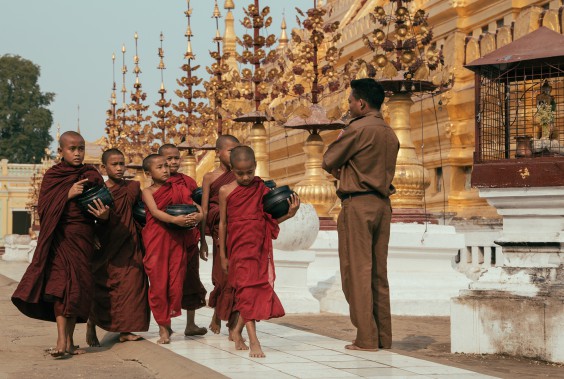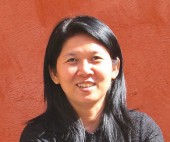Defining a National Identity Might Bring Peace to Myanmar
by Ma Thida / May 20, 2015 / 2 Comments

Young monks walk together outside of temple. Photo via Flickr user: Jérémy.
Myanmar struggles with ethnic and national identification, with the hopes of a peaceful integration.
We, Myanmar, ourselves need to answer a question: What is Myanmar society? What is our national identity? This is the key challenge we all in Myanmar now face. The current government lists 135 ethnic groups and these are grouped into 8 major national ethnic races: Kachin, Kayah, Kayin, Chin, Mon, Bamar, Rakhine, and Shan. There are altogether 64 languages spoken in Myanmar and these are grouped into 5 language families, including Sino-Tibetan, Tai-Kadai, and Hmong-Mien. So Myanmar is multi-ethnic community. And it is also multi-religious country. Though the government recognizes and lists four religions—Buddhism, Christianity, Hinduism and Islam—there are some other religious believers such as Jewish and Burmese folk religious believers. Amongst all this, how do we identify ourselves? This is still very unclear for the people of Myanmar.

- Literature is an echoing voice of people’s thought. Myanmar literature and media have suffered a lot along with people during five decades of censorship. The majority of Myanmar’s population are voiceless, and many untold stories are yet to be discovered by local or international writers and journalists. Here let’s try to find and listen to what problems people are feeling, thinking, and facing regarding freedom of expression in everyday lives in Myanmar.

- Ma Thida is a Burmese human rights activist, writer, medical doctor, and former prisoner of consciousness. In 1993, she was sentenced to twenty years in Burma’s Insein Prison for actively supporting the Nobel laureate Aung San Suu Kyi. She served six years of her sentence, largely in solitary confinement and was released through the efforts of Amnesty International and PEN International. She has published nine books in Burmese and English, including The Sunflower (1999), The Roadmap (2011), and Sanchaung, Insein, Harvard (2012), a memoir. Ma Thida is currently president of PEN Myanmar.
After a century-long repression, Myanmar people have lost their ability to think about their identity. A lot of people still cannot differentiate between race and ethnicity or between race and religion.
Indeed, before British colonial era, some ethnic monarchies in the vicinity of modern-day Myanmar had their own leaders like the king of Mon, Rakhine, or Shan saopha. They each had their own traditional, cultural, linguistic, ritualistic, behavioral, and religious traits. And they all were ruled by the dividing policy of British colonial government. That is why non-integrated and localized anti-colony movements by each ethnic group were easily cracked down on in very early days of colonialism.
During the time of nationalist movements against the British colony, several artists joined the movements by way of their art. At this time, literature, journalism, music, and plays mostly included either anti-foreigner or patriotic sentiment. And the biggest and strongest nation-wide anti-colonial organization was the Young Men’s Buddhist Association (YMBA) was the biggest and strongest nationwide anti-colonial organization While activists for independence activists tried to motivate and encourage people, the YMBA employed the phrase “protect the amyo, batha, thathana” and people understood it more widely. To them, amyo means race or ethnic group. And batha thathana does not simply mean religion, but more specifically Buddhism. People generally understood that they needed to protect their own race or ethnicity by boycotting foreigners, but not that they needed to protect it by boycotting all people of a different race or ethnicity because at the time, all races and ethnic groups in the country were ruled by foreigners and shared the sentiment of slaves, leading to a want for independence from foreigners’ colonies.
After independence, parliamentary government also tried to introduce Buddhism as the country’s religion, and this led some ethnic minorities to start an armed rebellion in some way, among other political problems. And religion is also used as a tool in winning an election by organizing the majority Bamar population, since Bamar is one of the 4 ethnic groups consisting mostly of Buddhists. Then the minority people also started to have feelings of bamanization in their being ruled by the majority of Bamar. Since most Bamar are Buddhists, people could not easily differentiate between Buddhists and Bamar, ethnicity and religion, i.e. amyo and batha. For them, amyo batha is understood as a single term meaning Bamar Buddhists. The majority of people also could not differentiate between nationality and ethnicity. So they could not count other race or ethnic groups or minorities who were born inside the country and lived with us together for decades as Myanmar nationalities. Those people are forced to understand that to protect amyo batha, or race and religion, means to protect Bamar or other listed ethnic Buddhists. This kind of understanding is mainly due to the lack of media freedom and freedom of expression. State-run media tries to propagandize this point, i.e. majority rules the country and other minorities should protect the majority. State-formed censorship tries to stop and block voices of ethnic and religious minorities by any means, such as media, literature. The state-sponsored education system also tries to block any critical thinking for both majority and minority youths.
Therefore, people today still use their illogical decisions to solve their daily life problems. People are used to believing in rumors and still don’t want to do research in order to judge whether the news or what they have heard is true or not. People are very good at criticizing the government but not at analyzing the issues. Poverty also plays a crucial role in paralyzing people in their capacity to contribute to the society. The education they have bars them in using analytical skill.
On the other hand, long term mistrust of the country’s unjust laws and its corrupted practitioners leads them to ignore the rule of law. They never feel safe under any laws. They lost their lands because of historically unjust laws, so they don’t believe or have no interest in relying on the rule of law.
All minority societies, especially those in ethnic rural areas, have lost their tolerance and resilience because of inequality, poverty, and poor education. They are looking for any reason to explode, such as racial or religious conflict; but the real problem is beyond those means. Ethnic minorities have lost their voices at both the national and regional levels. They even feel their ethnic identity has been lost.
This loss of individual and ethnic identity felt by citizens of Myanmar—whether they are Bamar or of other ethnic groups—is spreading at an alarming rate. Although they are called graceful under pressure, in so-called reform days, some groups of our people had been recognized differently. For example, even the International Crisis Group’s report in October 2014 said that the Rakhine community as a whole has tended to be cast internationally as one of violent extremists. This ignores the diversity of opinions that exist, the fact that the Rakhine themselves are a long-oppressed minority, and rarely attempting to understand their perspective and concerns. If we look at this note, we might raise the questions, “Why was the Rakhine community not being recognized the same way in the past? Did they really ignore the diversity of opinions? Or did we ignore the minority groups’ feelings of losing their identity for ages?” This prohibits them in accepting the majority’s different opinion as a diversity of opinions.
After the decades-long inability to express how they had been oppressed, non-military and civilian people are still feeling like second-class citizens compared to military people and people in power. Is the grief of ethnic minorities rooted in that they cannot identify who they really are? They were never well recognized as their own ethnic or racial or religious identity by authoritative governments in history. Both the state-run media and the state-sponsored education system never gave them the feeling of having private or public identity. Instead they have been forced to adopt the majority’s identity as their own.
Therefore, when the current government relaxed its political system, all groups—either minority or majority—aggressively defended their identity publicly. At that time most minorities just wanted to start claiming their minority ethnic identity since they had lost it for decades. In other words, people prefer ethnic identity over national identity. And they simply do not understand the concepts of ethnicity, race, nationality, and—eventually—democracy. So there are different kinds of fights and wars among different groups of people. Every single powerless minority inside our country is busy claiming back their respective identity from the government.
Therefore, the people of Myanmar have yet to define their national identity. They still cannot put themselves in the shoes of citizenship. They know they are diverse. They still do not know how to embrace this diversity since they are being denied diversity from militant military governments. These governments have taught them how to solve problems violently or brutally. The people never learned from these regimes how to build their nation peacefully, equally, and justly. They learned from these juntas how to discriminate others based on power, ethnicity, religion, and other traits. They do not even know what the national identity means since they have never proudly owned their own identity.
That is why we, Myanmar, are facing a lot of problems. Every single citizen of our country has started looking for consensus regarding our national identity. Only then may we easily be integrated peacefully.





2 Comments on "Defining a National Identity Might Bring Peace to Myanmar"
Great article and said things urgently needed to be known by the Myanmar as well as the international groups and media, all which too often can only see or acknowledge the emotional or the trendy political correctness part of the situation.
Let me give you an example of Turkish-Kurdish conflict . Do you think all of Kurdish people don’t understand between National identity vs their ethnic identity?Why those Kurdish people are happier and easier to integrated into US and UK community rather than their closer friend Turkish people.?Think also that way in Burma.